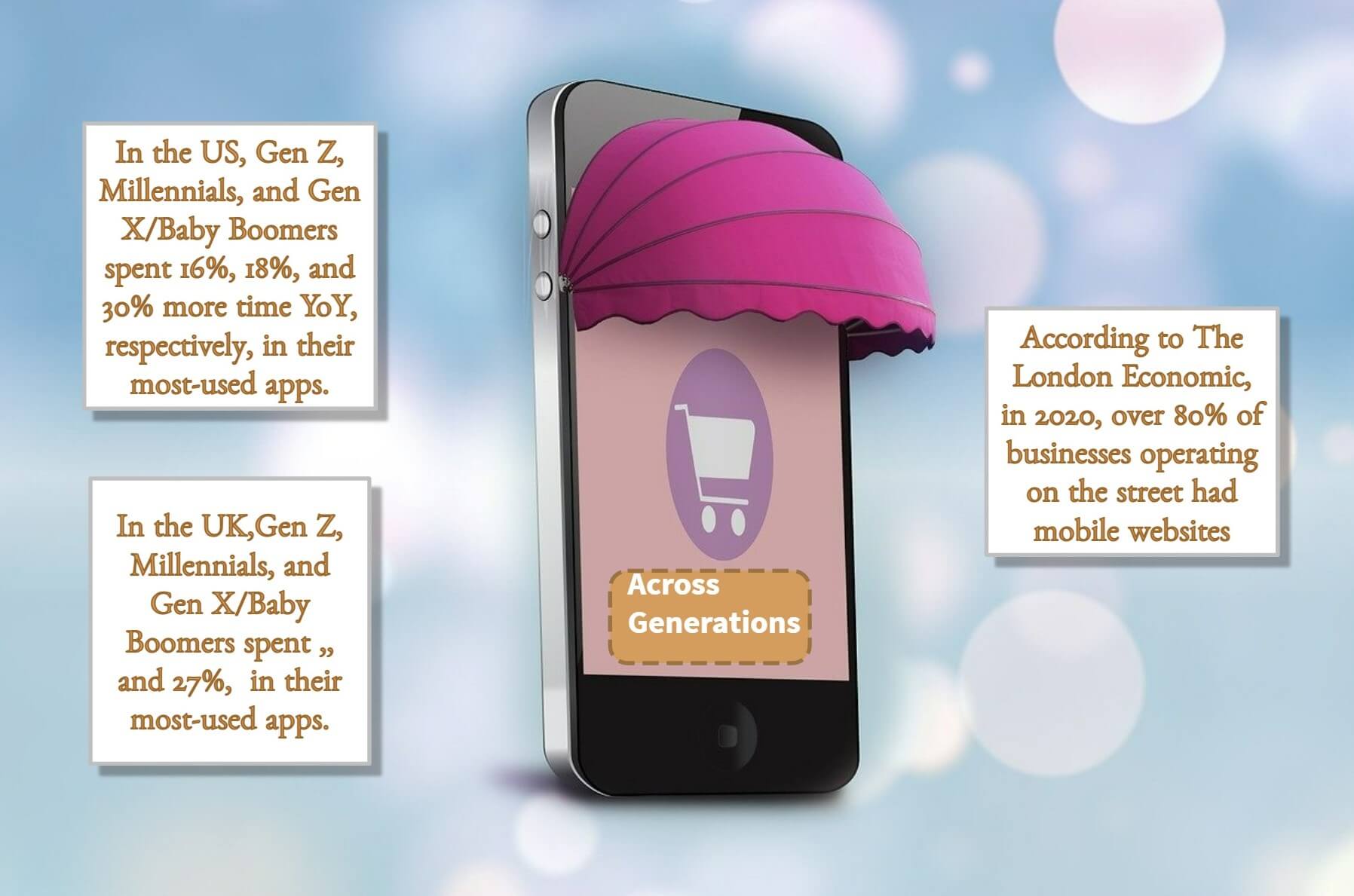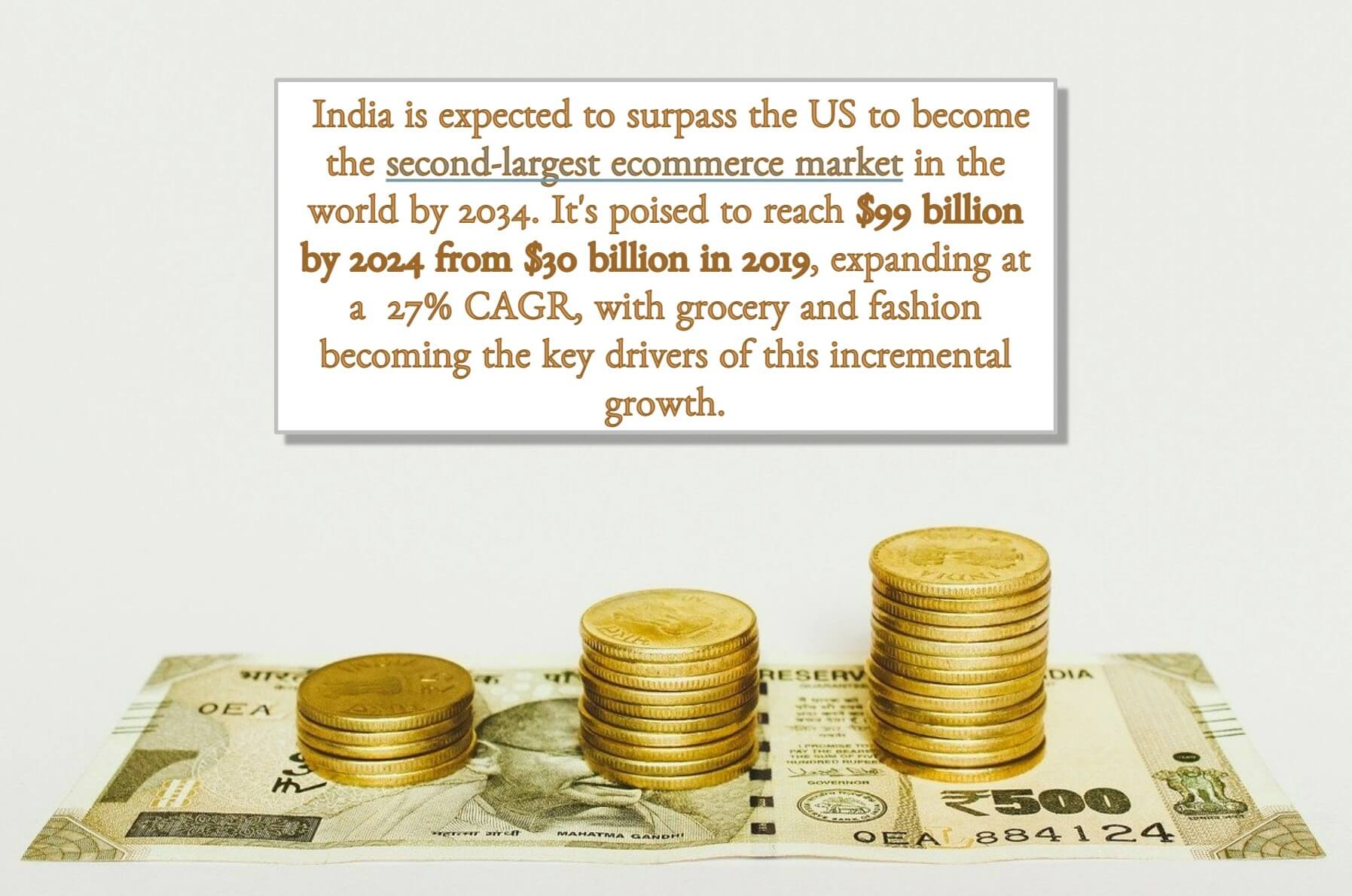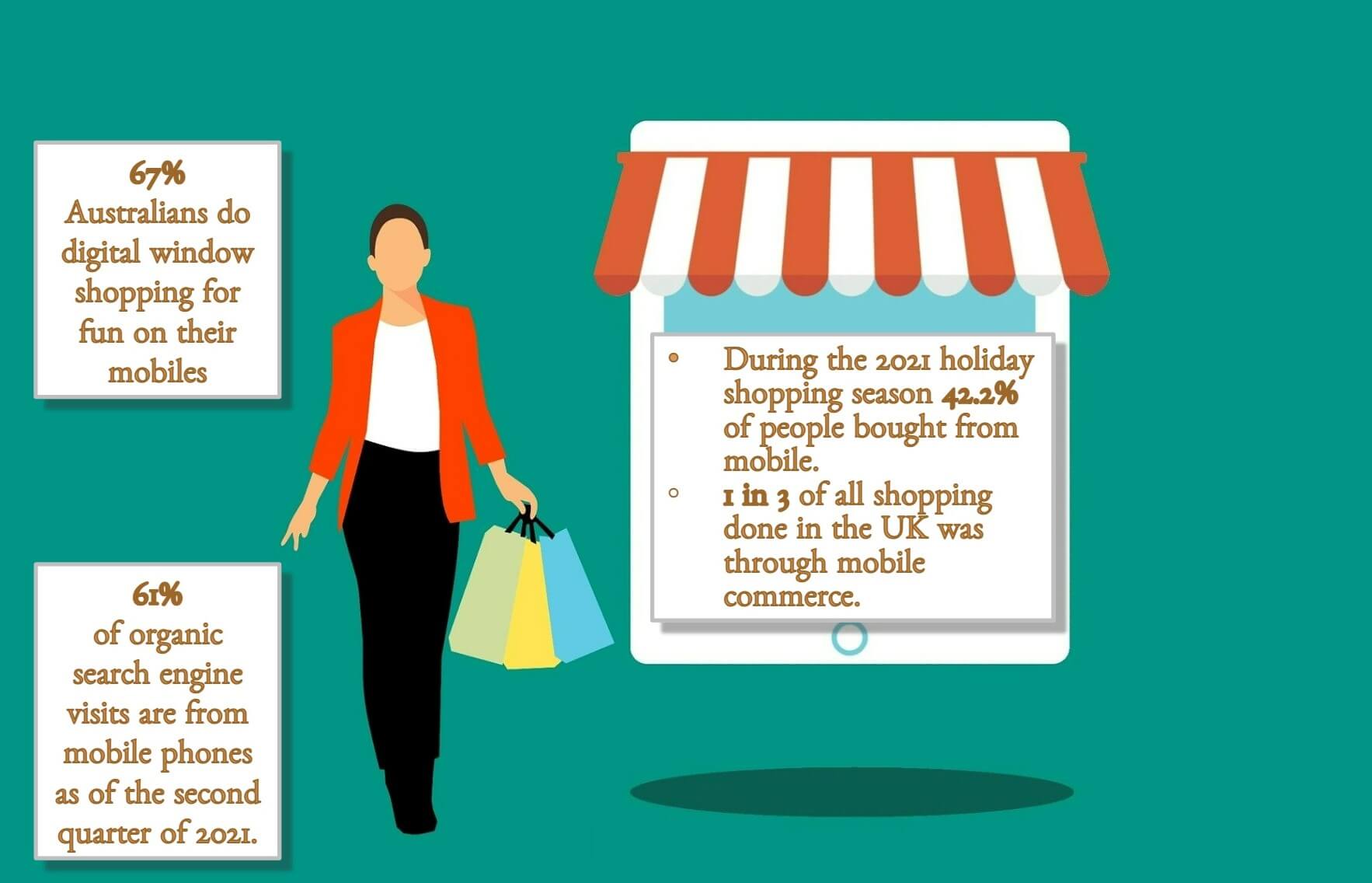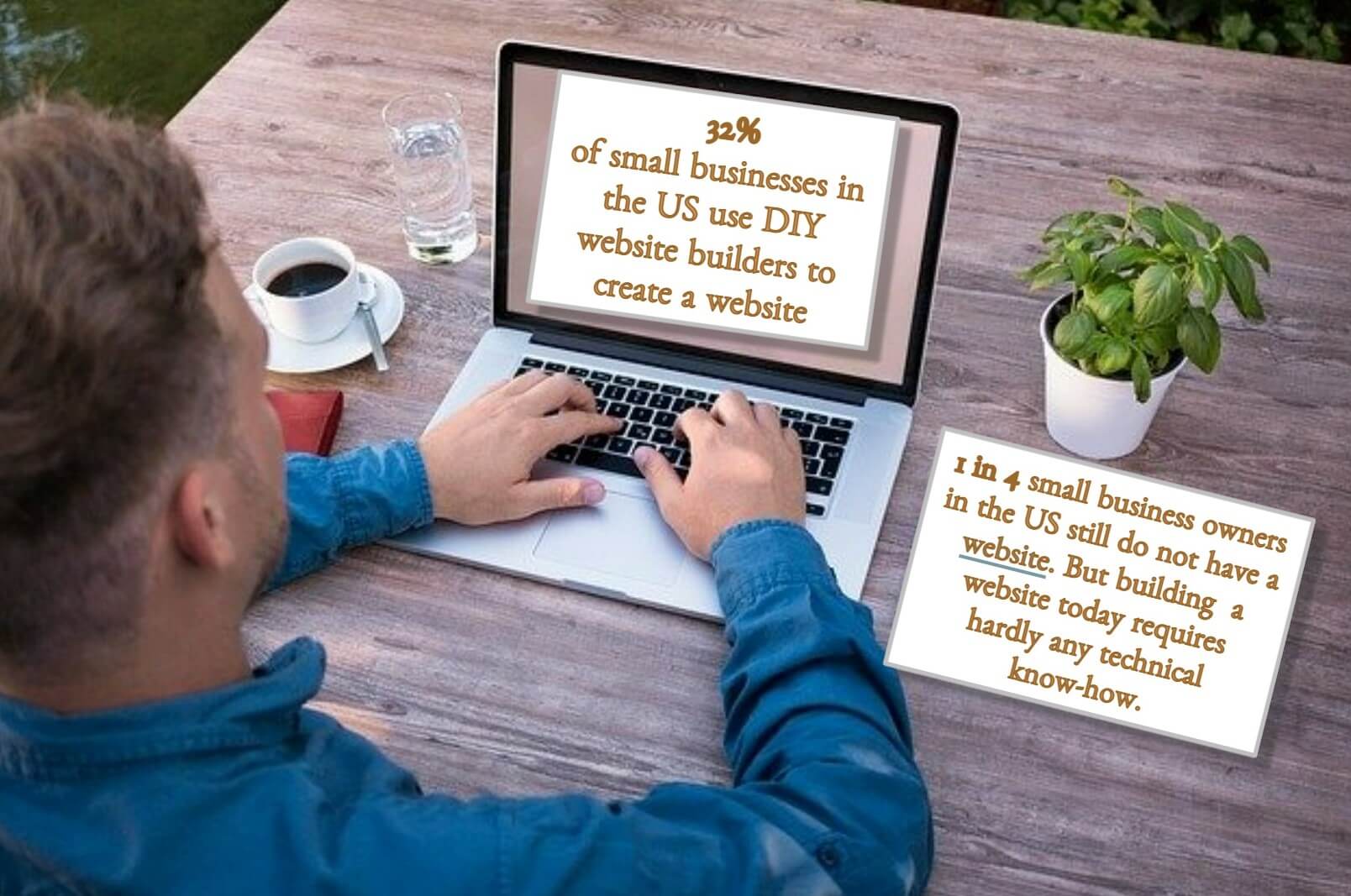- HOME
- Ecommerce trends
- Mobile commerce: Strategies and tips to get started and succeed
Mobile commerce: Strategies and tips to get started and succeed

The ecommerce boom of the last two years can be attributed to the pandemic to some extent. With lockdowns across the world, many brick-and-mortar businesses warmed up to the idea of selling online. Today, even traditional businesses feel the need to have an active online store for business continuity in times of restrictions on social gathering.
Today, we're going to explore how mobile commerce is expected to grow worldwide, and what's in it for you. We'll also look at how your business can make the most of these trends.

What does mobile bring to ecommerce?
Smart mobile devices and cheap data have kicked off a generational change. The future belongs to mobile devices, and this has been corroborated many times over by studies from across the world.
Ecommerce growth has been complemented worldwide by this mobile penetration and internet usage, making mobile commerce a sub-category—but a significant one—in the commerce space.

There are two primary advantages of optimizing for mobile commerce:
Reach and Engagement: The State of Mobile report from App Annie, a leading provider of mobile data and analytics, shows some significant details that tell you why you need to ace the game in mobile commerce in 2022. It said that mobile took over mindshare at 3.5 trillion hours on Android phones annually. Mobile is the only channel with this reach and depth of engagement.
Mindshare: The 2018 PayPal mCommerce Index Report revealed that mobile shopping has become a form of entertainment for consumers. Given this trend, your store needs to engage your customers enough to entertain, and more, to make them keep coming back.
Australian retailers no longer view their mobile offering as a transactional storefront, but as a platform to deliver enjoyment, entertainment, and social sharing .
Elaine Herlihy, Australia Director of Customer Engagement, Paypal

As consumers spend increasingly more time on their devices, you need to ascertain if you are ready as an entrepreneur to meet them there. In other words, do you have a solid mobile commerce strategy in place for your store so that it works as seamlessly on mobile as it does elsewhere?
How to transform your ecommerce business for mobile
Make search easy
The search option on an ecommerce store plays the role of an enterprising sales person in a store, who lays out not only what has been asked, but also related objects to induce the visitor to buy. Searching on a mobile device can be tougher than on a desktop because of the size of the screen and the small keypad. Also, typos are common when searching on mobile. A search bar is important on your mobile website as people try to type what they want rather than browsing through the website (which is zoomed in and usually just shows two products at a time).
On the website of plant-based specialty store KukClean, the search bar is prominently displayed at the top, as can be seen below in the screenshot of their mobile store.

TIP: A good ecommerce site-builder should ideally take care of these aspects automatically. Read more here.
Guarantee a secure payment process
Security is of foremost importance in an online transaction. On a daily basis, thousands of users will be sharing their credit card data while making payments on your store, which will be transmitted through card processing transactions. Businesses are expected to have PCI (Payment Card Industry) compliance so that the transactions are safe. According to research from TransUnion, an American consumer credit reporting agency, almost 18% of all global ecommerce transactions between Thanksgiving and Cyber Monday were potentially fraudulent.
Check the above screenshot from the website of Partsbaba, an online printer parts store. Placing compliance badges like these go a long way in reassuring your customers about the safety of transactions done on your online store.
TIP: Good ecommerce site-builders ensure that the websites follow PCI compliance. The Payment Card Industry Data Security Standard (PCI DSS) enforces a set of practices to be followed by companies that process, store, or transmit card details in order to protect their customers’ card information. Learn more about this here.
Make paying easier
In 2018, it was noted that more than half the people in the US used their mobile phone for their most recent bill payment. The number has only risen over the years. The recent World Pay Global Payments Report revealed interesting trends about payment worldwide. The pandemic has accelerated the decline of cash by over three years, and consumer payment preferences have changed significantly. Even physical credit cards have taken a backseat and digital wallets have more takers. The rise of mobile banking has also made smart phones and tablets all the more significant in the payment process. It also says that more than 52% of purchases will be made with a digital wallet. All these factors emphasize the need for your online store to be easily accessible on the phone.
Did you Know: Mobile optimization is key to engaging millennials, as can be understood from the PayPal mCommerce Index. It says one in three users in the age group 18-34 abandon purchases or payments because they weren’t mobile-optimized, and over half (57%) say they get annoyed by sites that aren’t mobile-friendly! A good checkout process is the backbone of payments in an ecommerce store, and building your store on a platform that ensures this will save you a lot of trouble.
Focus on consumer needs
If a customer walks into your store, you'll surely make a mental note of their age and social background while helping them make a decision. The same should go for an online store. For instance, if your store is targeting Boomers, a huge issue they can have while buying on the phone is that the text is not legible for them to read. After a particular age, it becomes difficult for people to follow complex UIs, so multiple levels of the checkout process can be cumbersome for them. While designing a store, keep your target user and their needs in mind. Just to gain some perspective, you can read more about the example we have given here.

Offer compatibility with different devices
With people increasingly using their mobile devices while shopping, it becomes imperative to create a store that has a responsive design—i.e. web pages that adapt easily to a variety of devices (be it desktop, tablet, or mobile) to ensure usability and satisfaction. A responsive design also ensures a seamless customer experience across devices and easy sharing of links on social media, so customer acquisition and retention both become easier.

Check the above image from the site of Vivapura Superfoods. Compare this with the mobile site of their ecommerce store below. Note how a responsive design helps in quick adaptation to any device, making it easy for the user.

TIP: Great site builders will automatically provide you a responsive design that looks great on both desktop and mobile devices. Learn more here.
Use good layouts and templates
You've likely heard the oft-repeated notion that an average user takes about 50 milliseconds (that's 0.05 seconds) to form an opinion about a website. While that sounds too quick, perhaps it's true. As someone who runs an ecommerce store or visits an ecommerce store, by now you will surely agree that a layout and template should reflect the personality of the brand and the store.
TIP: Good site builders always keep different business requirements in mind while coming up with multiple options for templates. Learn more here.

Ask for relevant details only when collecting data
Customers can be quite conservative with their information while buying your products. Making them fill out long forms before purchase can be a huge turnoff. Many successful websites allow customers to make their purchase as a guest rather than logging into the store. The most important thing is to get the details that are essential to complete the transaction and make a safe delivery. Any more than that can come across as an invasion of their privacy.
Tip: While enabling a guest checkout makes the process faster, it can come with its own drawbacks. Check out this article on the merits and demerits of a guest checkout, and you will be able to weigh the options in a better way. Another way of making this simple is by enabling social login, whereby your customers can use their existing social media profile to log in.
Tell a story with pictures
Remember how you never got enough of your childhood comics because of the wonderful illustrations and pictures that told a wonderful story? Well, turns out that adults aren't quite different when it comes to absorbing ideas through pictures and processing them faster than words. At a very basic level, know that pictures can bring any website to life. From a design perspective, they help break the monotony of a text-heavy page.

Check out the website of Corbell Silver, which sells fine silver objects and antiques. Good product shots have elevated the user experience while also projecting a great image of the business. Most importantly, they help its customers get a fair idea of what they're setting out to buy.
For an ecommerce site, it's imperative to have high quality pictures that showcase your offerings, but it's also important to focus on the details. For instance, if you are a clothing brand or selling artifacts online, customers will want to zoom in and check out the fine details of your product before making up their mind. Do you have pictures that make this convenient? A high quality image doesn't necessarily mean a large file that can take longer to load. You can resize your image online using tools like Photoshop or Pixlr while keeping its quality intact.
Tip: One tool that can be a life-saver when creating simple designs and templates is Canva. If you haven't started using it for your website designs and social media posts, it's high time you do so. Check out this article to learn how you can create impressive social media posts for Canva. Here's an interesting post that tells you the importance of having good pictures on your website.
Prioritize customer care
It's pertinent to ask why it's essential that people can easily reach out for help while using an ecommerce store. People are buying things online while they're on the go, whether they're eating at a restaurant or taking a cab. In such a scenario, they might want to reach out to solve their queries at any given point of time. It helps if your store can offer more than just a website. For instance, Zoho Commerce has interesting plugins and integrations that help businesses engage with customers 24x7 and also automate several business functions. This makes it convenient not only for the customer of a given store, but also for the business owner.
Tip: It's not practical—and basically impossible—to sit 24x7 in front of your system attending to customer queries and resolving issues. It has become imperative to use automation tools that come in handy for your day-to-day business. Customer service software solutions have become game changers for today's business.
So if you've yet to take the leap into the world of ecommerce, it's high time you do it. And if you're already in the game, make sure you're ready for the world of mobile commerce, which is full of opportunities.
